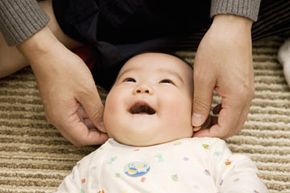I know adults have hectic lives, but it seems to me that the kids are the ones who really need the occasional massage. They juggle school, sports, chores, mean kids, social lives, acne, peer pressure and about a hundred or so other stressors. So, why do so many spas discourage or limit massage therapy for the under-18 crowd? We'll get to the rationale behind the rules soon, but first it's important to know what massage can do for your kid.
The vast majority of massage professionals will readily admit that no one is too young to appreciate and benefit from a good massage. In fact, the massage experience can begin as early as infancy and continue throughout life, as long as a licensed professional is used. Studies have repeatedly shown that massage helps kids and adults of all ages with stress and stress hormone levels, mood and behavioral problems. The immune system can also enjoy a much-needed boost from a regular rubdown. Plus, they're just fun and relaxing, and who doesn't need a little bit of that?
Advertisement
In addition, physically active teens are sure to appreciate the sports-related benefits of massage. For example, massage therapy has been proven to aid sore muscles and specific pain (such as lower back spasms or hamstring troubles). Other teen-specific pros include the fact that massage relieves the symptoms of PMS; plus, studies have shown that people are more alert following a session. SAT prep, anyone?
But there are a couple of factors to take into consideration before plopping your child down on a massage table. First, younger kids only need a 15 or 20-minute session to get the job done because an entire hour would be too overwhelming. In fact, parents can learn to give basic massages to younger kids at home. Since teens would probably balk at the idea of a mommy massage, they're best left to the capable hands of licensed massage therapists. Before you make a spa appointment, though, check the age requirements to avoid disappointment.
On the next page, you'll learn about spa requirements for children and teens, and why they exist.
Advertisement


